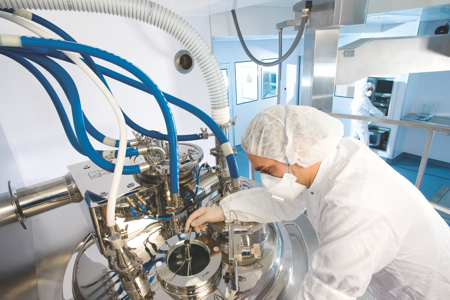Ensuring long-term success in the pharmaceutical industry is increasingly difficult in the face of challenges such as patent expirations, weak product development pipelines, pressure to lower prices, and a progressively burdensome regulatory environment. Pharmaceutical companies need to be reliable, flexible and innovative if they want long term productivity and profitability.
The economic downturn in 2009 led many pharmaceutical companies to embrace cost reduction measures focused on increasing efficiency. An efficient business process can guarantee both a high level of quality and shorter lead times between production and distribution. However, these measures were often short-term fixes, and manufacturers were unable to guarantee long-term reliability.
Instead, they needed to find cost-effective ways to increase efficiency that could be used over a longer period of time, to ensure stability, and form the basis for future growth. When this is achieved, pharmaceutical companies can position themselves for long-term success and grow in a way that allows for continuous improvement.
One solution is to use a technique called Lean Management methods. Ultimately, Lean Management is all about eliminating waste, defined as anything that delays work or requires activities that do not directly contribute value to the manufacturing process in order to increase efficiency.
Overproduction and overstocking is also seen as waste. For example, producing more drugs than necessary means excess product will need to sit in a storeroom, which is an inefficient use of space.

Using Lean Management methods means sustainably changing manufacturing processes to reflect customer demand while maintaining cost-efficiency
Using Lean Management methods means sustainably changing manufacturing processes to reflect customer demand while maintaining cost-efficiency. This way, customer needs can be dealt with flexibly according to demand, thereby reducing backorders and excessive stock – both of which can lower efficiency and raise costs for the manufacturer.
Of course, taking into account company goals is equally important. Support from management is paramount to achieving success. Company management needs to identify goals and use these to define KPIs and as reference values for periodic reviews. Communicating openly and being proactive are critical.
For example, the medical device manufacturer ConMed was facing a very specific problem and knew it needed to alter its manufacturing techniques: ‘We weren’t trying to get faster or save money; we were trying to become more reliable,’ says Dave Johnson, Vice President of Global Operations. The company was using inefficient and wasteful production processes. It had large quantities of work-in-process (WIP), high productivity losses and excessive stock.
Within a year of altering its manufacturing processes according to Lean methods, ConMed’s productivity increased by 22% and WIP was curtailed by as much as 85%. It has since increased efficiency to the extent that today there are no more than 24 hours between the placing of an order and product delivery. ConMed has become far more reliable and is flexible according to customer demand.
Exceed regulatory requirements
Lean methods can work for more than just increasing reliability. Active Pharmaceutical Ingredients manufacturer Roche Pharmaceuticals had two specific goals in mind when the firm decided to make changes to its processes. First, it wanted to reduce the number of observations from the US Food and Drug Administration (FDA) by meeting or exceeding regulatory requirements. Second, it wanted to cut product delivery times.

Roche Pharmaceuticals had two specific goals in mind when it combined Lean methods with a series of principles known as 5S
Roche combined Lean methods with a series of principles known as 5S, which include consolidating databases; ensuring materials are effectively labelled; developing a standardised production plan; and reducing hiring time for lab technicians.
The 5S process also improved cleanliness at the workplace, enhancing individual employees’ sense of responsibility. The company began using daily, weekly and monthly checklists, which created a constant state of FDA inspection readiness. As a result, zero observations were made during the next FDA audit. Test schedules were reduced by around 65% and Tracy Taylor, Manager of Quality Control at Roche Pharmaceuticals, noted that the firm was ‘able to reduce the product test phase prior to delivery from 14 to just five days’ – an industry-leading level – despite experiencing a five-fold increase in output.

Lean methods can work for more than just increasing reliability
Whatever your company’s goals, changing the mentality surrounding the manufacturing process provides the starting point for lasting success. Success can be maintained only if your products are consistently available and of a high quality; you can be flexible and cater to fluctuations in demand at short notice; and you can regularly be innovative and enhance your product offerings. For some companies, this may mean making a lot of alterations to processes.
When implementing Lean methods – or, indeed, any change to your pharmaceutical manufacturing technique – it can be difficult to avoid reverting to old habits. External pressures to cut costs and the regulatory environment exert a lot of stress on manufacturers.
But making a few internal changes and sticking to them means a more efficient business with a competitive advantage in an already challenging industry.




